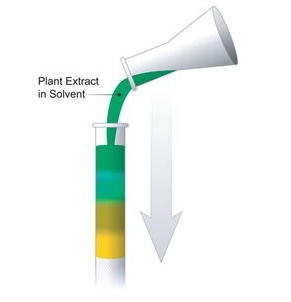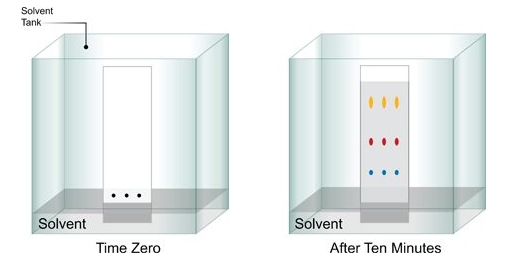Brief History and Some Definitions
Liquid chromatography (LC) was defined in the early 1900s by the work of the Russian botanist, Mikhail S. Tswett. His pioneering studies focused on separating compounds [leaf pigments], extracted from plants using a solvent, in a column packed with particles.
Tswett filled an open glass column with particles. Two specific materials that he found useful were powdered chalk [calcium carbonate] and alumina. He poured his sample [solvent extract of homogenized plant leaves] into the column and allowed it to pass into the particle bed. This was followed by pure solvent. As the sample passed down through the column by gravity, different colored bands could be seen separating because some components were moving faster than others. He related these separated, different-colored bands to the different compounds that were originally contained in the sample. He had created an analytical separation of these compounds based on the differing strength of each compound’s chemical attraction to the particles. The compounds that were more strongly attracted to the particles slowed down, while other compounds more strongly attracted to the solvent moved faster. This process can be described as follows: the compounds contained in the sample distribute, or partition differently between the moving solvent, called the mobile phase, and the particles, called the stationary phase. This causes each compound to move at a different speed, thus creating a separation of the compounds.
Tswett coined the name chromatography [from the Greek words chroma, meaning color, and graph, meaning writing—literally, color writing] to describe his colorful experiment. [Curiously, the Russian name Tswett means color.] Today, liquid chromatography, in its various forms, has become one of the most powerful tools in analytical chemistry.
 Figure A: Tswett’s Experiment
Figure A: Tswett’s ExperimentLiquid Chromatography (LC) Techniques
Liquid chromatography can be performed using planar [Techniques 1 and 2] or column techniques [Technique 3]. Column liquid chromatography is the most powerful and has the highest capacity for sample. In all cases, the sample first must be dissolved in a liquid that is then transported either onto, or into, the chromatographic device.
Technique 1. The sample is spotted onto, and then flows through, a thin layer of chromatographic particles [stationary phase] fixed onto the surface of a glass plate [Figure B]. The bottom edge of the plate is placed in a solvent. Flow is created by capillary action as the solvent [mobile phase] diffuses into the dry particle layer and moves up the glass plate. This technique is called thin-layer chromatography or TLC.
 Figure B: Thin-layer Chromatography
Figure B: Thin-layer ChromatographyNote that the black sample is a mixture of FD&C yellow, red and blue food dyes that has been chromatographically separated.
Technique 2. In Figure C, samples are spotted onto paper [stationary phase]. Solvent [mobile phase] is then added to the center of the spot to create an outward radial flow. This is a form of paper chromatography. [Classic paper chromatography is performed in a manner similar to that of TLC with linear flow.] In the upper image, the same black FD&C dye sample is applied to the paper.
 Figure C: Paper Chromatography
Figure C: Paper ChromatographyNotice the difference in separation power for this particular paper when compared to the TLC plate. The green ring indicates that the paper cannot separate the yellow and blue dyes from each other, but it could separate those dyes from the red dyes. In the bottom image, a green sample, made up of the same yellow and blue dyes, is applied to the paper. As you would predict, the paper cannot separate the two dyes. In the middle, a purple sample, made up of red and blue dyes, was applied to the paper. They are well separated.
Technique 3. In this, the most powerful approach, the sample passes through a column or a cartridge device containing appropriate particles [stationary phase]. These particles are called the chromatographic packing material. Solvent [mobile phase] flows through the device. In solid-phase extraction [SPE], the sample is loaded onto the cartridge and the solvent stream carries the sample through the device. As in Tswett’s experiment, the compounds in the sample are then separated by traveling at different individual speeds through the device. Here the black sample is loaded onto a cartridge. Different solvents are used in each step to create the separation.
 Figure D-1: Column Chromatography – Solid-Phase Extraction [SPE]
Figure D-1: Column Chromatography – Solid-Phase Extraction [SPE]When the cartridge format is utilized, there are several ways to achieve flow. Gravity or vacuum can be used for columns that are not designed to withstand pressure. Typically, the particles in this case are larger in diameter [> 50 microns] so that there is less resistance to flow. Open glass columns [Tswett’s experiment] are an example of this. In addition, small plastic columns, typically in the shape of syringe barrels, can be filled with packing-material particles and used to perform sample preparation. This is called solid-phase extraction [SPE]. Here, the chromatographic device, called a cartridge, is used, usually with vacuum-assisted flow, to clean up a very complex sample before it is analyzed further.
Smaller particle sizes [<10 microns] are required to improve separation power. However, smaller particles have greater resistance to flow, so higher pressures are needed to create the desired solvent flow rate. Pumps and columns designed to withstand high pressure are necessary. When moderate to high pressure is used to flow the solvent through the chromatographic column, the technique is called HPLC.
What Is High Performance Liquid Chromatography (HPLC)?
The acronym HPLC, coined by the late Prof. Csaba Horváth for his 1970 Pittcon paper, originally indicated the fact that high pressure was used to generate the flow required for liquid chromatography in packed columns. In the beginning, pumps only had a pressure capability of 500 psi [35 bar]. This was called high pressure liquid chromatography, or HPLC. The early 1970s saw a tremendous leap in technology. These new HPLC instruments could develop up to 6,000 psi [400 bar] of pressure, and incorporated improved injectors, detectors, and columns. HPLC really began to take hold in the mid-to late-1970s. With continued advances in performance during this time [smaller particles, even higher pressure], the acronym HPLC remained the same, but the name was changed to high performance liquid chromatography.
High performance liquid chromatography is now one of the most powerful tools in analytical chemistry. It has the ability to separate, identify, and quantitate the compounds that are present in any sample that can be dissolved in a liquid. Today, compounds in trace concentrations as low as parts per trillion [ppt] may easily be identified. HPLC can be, and has been, applied to just about any sample, such as pharmaceuticals, food, nutraceuticals, cosmetics, environmental matrices, forensic samples, and industrial chemicals.
 Figure D-2: HPLC Column
Figure D-2: HPLC Column
What Is UltraPerformance Liquid Chromatography (UPLC Technology)?
In 2004, further advances in instrumentation and column technology were made to achieve very significant increases in resolution, speed, and sensitivity in liquid chromatography. Columns with smaller particles [1.7 micron] and instrumentation with specialized capabilities designed to deliver mobile phase at 15,000 psi [1,000 bar] were needed to achieve a new level of performance. A new system had to be holistically created to perform ultra-performance liquid chromatography, now known as UPLC technology.
Basic research is being conducted today by scientists working with columns containing even smaller 1-micron-diameter particles and instrumentation capable of performing at 100,000 psi [6,800 bar]. This provides a glimpse of what we may expect in the future.
Why is HPLC used?
High-performance liquid chromatography (HPLC) is a chromatographic technique used to split a mixture of compounds in the fields of analytical chemistry, biochemistry and industrial. The main purposes for using HPLC are for identifying, quantifying and purifying the individual components of the mixture.
What does HPLC stand for?
Expand the acronym?High-performance liquid chromatographyHigh-performance liquid chromatography (HPLC), formerly referred to as high-pressure liquid chromatography, is a technique in analytical chemistry used to separate, identify, and quantify each component in a mixture.
Why HPLC is called High Performance?
HPLC stands for High Performance Liquid Chromatography.
Its earlier name was High Pressure Liquid Chromatography because it involved use of liquid mobile phase requiring higher pressures than gases used in Gas Chromatography.
When was HPLC invented?
1967The first commercially available HPLC system, the ALC100 HPLC, was developed by Waters Associates (now Waters Corporation), a company offering analytic tools and systems to scientists, in 1967. By the 1980s, HPLC was being commonly used in the world of science.
Which detector is used in HPLC?
HPLC Detectors
- UV-Vis Detectors. The SPD-20A and SPD-20AV are general-purpose UV-Vis detectors offering an exceptional level of sensitivity and stability. …
- Refractive Index Detector. …
- Fluorescence Detectors. …
- Evaporative Light Scattering Detector. …
- Conductivity Detector.
What is the basic principle of HPLC?
The separation principle of HPLC is based on the distribution of the analyte (sample) between a mobile phase (eluent) and a stationary phase (packing material of the column). Depending on the chemical structure of the analyte, the molecules are retarded while passing the stationary phase.
What are the types of HPLC?
Types of HPLC
- Normal Phase HPLC. This method separates analytes on the basis of polarity. …
- Reverse Phase HPLC. The stationary phase is nonpolar (hydrophobic) in nature, while the mobile phase is a polar liquid, such as mixtures of water and methanol or acetonitrile. …
- Size-exclusion HPLC. …
- Ion-Exchange HPLC.
What is mobile phase in HPLC?
High Performance Liquid Chromatography (HPLC) is a form of column chromatography that pumps a sample mixture or analyte in a solvent (known as the mobile phase) at high pressure through a column with chromatographic packing material (stationary phase).
Why pH is important in HPLC?
When samples contain ionisable compounds, mobile phase pH can be one of the most important variables in the control of retention in a reversed‑phase HPLC (RP-HPLC) separation. … Since most compounds analysed by RP-HPLC contain one or more acidic or basic functional groups, most mobile phases require pH control.
Is HPLC quantitative or qualitative?
Analyzing the HPLC-collected components by IR or mass spectroscopy enables reliable qualitative analysis.
Why UV detector is used in HPLC?
HPLC UV/Visible detectors are used with high performance liquid chromatography to detect and identify analytes in the sample. The analyte can be identified by measuring the sample’s absorption of light at different wavelengths. The UV absorbance differs depending on what wavelength is used.
What is RT and RRT in HPLC?
In high pressure liquid chromatography (HPLC), the compound is injected through a column of different sized beads.The amount of time it takes for the compound to pass through the column is the retention time (RT). The relative retention time (RRT) is the comparison of the RT of one compound to another.